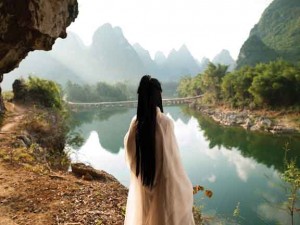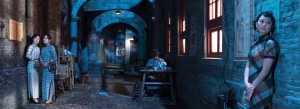« Reviews
Isaac Julien
Bass Museum of Art - Miami Beach
By Margery Gordon
Sense of place is heightened in Isaac Julien’s films, context inspiring content in settings rendered at once hyper-realistic and fantastical. Sumptuous vistas saturated with pigment and portent transcend supporting parts as mere set pieces to upstage even the human actors for star billing. This winter’s survey at the Bass Museum adapts four films and corresponding stills to the unique contours of the original building and modern addition, at turns magnifying the work’s grand scale and tempering it with architectural intimacy while enhancing its historical resonance.
The museum settings of two earlier films echo in ambient alcoves leading into the galleries of Renaissance and Baroque works, now interspersed with stills of spectators posed before other artworks, telescoping the viewing experience itself. The 16th century tapestry covering the far wall represents the apropos struggle with “how to collapse time to show different events on a large ‘screen,’” (remarked by John Hanhardt, consulting senior curator of media arts for the Smithsonian, as he lectured in front of it in January). Hanhardt observed that Julien continues to experiment with “how he can shape the space and then represent the performer moving through that space.”

Isaac Julien, Mazu, Silence (Ten Thousand Waves), 2010, Endura Ultra photograph 70 7/8” x 94 ½.” All images are courtesy of the artist, Victoria Miro Gallery, London and Metro Pictures, New York.
Eighteenth-century ghosts animate the Sir John Soane museum of colonial loot in London, emerging from the shadows in Vagabondia (2000). A gypsy dances among the statues, his impish movements (choreographed by Javier De Frutos) mirrored in a split screen. This bifurcated frame expands and contracts the picture plane so that paintings and characters vanish into its fold and rematerialize in the visions of a black female conservator. The projection glimmers in a red alcove, its low ceiling drawing the gaze downward and enhancing the voyeuristic intensity.
A larger blue chamber hosts Baltimore, which collapses three of the city’s institutions: the Walters Art Museum, the Contemporary Museum, and the Great Blacks in Wax Museum. Julien filmed it in 2002 while working on his documentary Baadasssss Cinema, and this retro-futuristic homage appropriates hallmarks of the blaxploitation genre. A militant “Afro-cyborg” femme fatale struts past Egyptian artifacts and hurtles from a catwalk, soaring down several stories through an atrium bordered by weighty tomes. She lands face-to-face with iconic auteur Melvin Van Peebles, who later confronts his own cigar-chomping synthetic doppelganger and contemplates an El Greco. The allegorical protagonists and hybrid galleries merge eras onscreen as the Bass marries its historical collection with cutting-edge installations.
The racial unrest of 1960s London shares screen-time with a present-day Saint Lucia-connecting Julien’s Anglo-Saxon hometown with his Afro-Caribbean heritage-in Paradise Omeros, which cycles through dream sequences loosely based on Derek Walcott’s 1990 poem Omeros (the Greek name for Homer). That time-shifting tale of ancestral disconnect alludes to the archetypal wandering hero in an Odyssey that traces a Saint Lucian fisherman’s lineage far back to his slave progenitor. Walcott, a Saint Lucia native and Nobel Prize winner, collaborated with composer Paul Gladstone Reid and Julien on a film score incorporating incantatory Creole verse. A young black man (seemingly a version of the artist as a young man) in a crisp white uniform waits on an island resort guest whose rings spell out LOVE and HATE, then wades into the surf as the camera cuts cryptically between these obvious symbols and a gray cityscape of red X chalkmarks on concrete walls that hide him from a hitman and attack dogs. A spinning record transports the teen to an urban apartment where he witnesses the beating of a black man on a bed while partygoers in ‘60s finery dance on undaunted. A crowd encircles the youth as he is crowned by a maternal figure in a ceremony lacking celebratory spirit. “I was a lost soul,” a voiceover intones, bemoaning the linguistic and conceptual confusion that accompanies expatriation. “What was not clear was who I was and why I was there.”

Isaac Julien, Blue Goddess (Ten Thousand Waves), 2010, Endura Ultra photograph diptych, 70 7/8” x 106 5/16.”
A ramp bridges this oceanic interlude projected at its base with Ten Thousand Waves, Julien’s most ambitious installation, making its U.S. debut in the main exhibition space upstairs, large glossy photographs of several scenes leading the way. The 2010 epic ups the ante as Julien’s consistent themes about the complications of migration and imperialism become less personal and more political, expanding to a global scale and enveloping participants in a sweeping tableaux projected on nine vast screens. Julien was initially inspired by a 2004 tragedy in which 23 Chinese migrant laborers drowned while picking cockles in northern England’s Morecambe Bay, here represented by footage and audio from a helicopter sweeping the Welsh shoals for survivors. All of the screens fill with rough waves for a disorienting three-dimensional effect, submerging each viewer in the fast-rising high tides, and soon span placid waters framed by majestic mountains in Fujian Province, where the exploited pilgrims originated as well as the mythical goddess Mazu. Legendary actress Maggie Cheung fleshes out the fabled Tale of Yishan Island as the immortal savior who led 16th-century fishermen lost at sea to safety, and now guides viewers through an exotic landscape.
Another enchantress, Zhao Tao, stars in a meta-cinematic restaging of the 1934 Chinese classic The Goddess as a solitary prostitute pacing the alleyways of Old Shanghai and waiting patiently (for an unseen client?) in atmospheric modern settings, perched on a vintage purple settee amid prismatic glass panels and trapped in one of the skyscrapers transforming the metropolis. Flickering night lights and spiraling overpasses contrast current Shanghai sights with archival footage of streetcarts and Communist marches, old and new coexisting on neighboring panels that alternate images and angles to constantly shift the audience’s optical and psychological points of view. Julien ultimately exposes the machinery behind the magic: production assistants hoist Cheung in Mazu’s flowing robes on wires temporarily visible against a green screen, and master calligrapher Gong Fagen appears to paint the lens with an oversized Chinese character, thus breaking the fourth wall for a fitting coda.
(December 2, 2010 - March 6, 2011)
Margery Gordon is a freelance arts journalist who works for ARTnews, Art + Auction, ArtInfo.com, and the official Art Basel Miami Beach Magazine, among other publications. She is a professor at Barry University in Miami.
Filed Under: Reviews


































